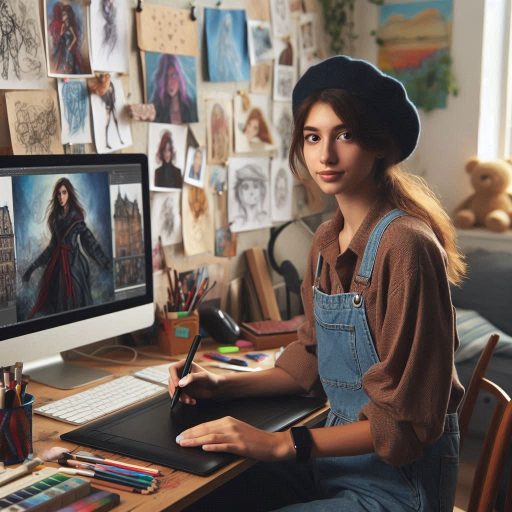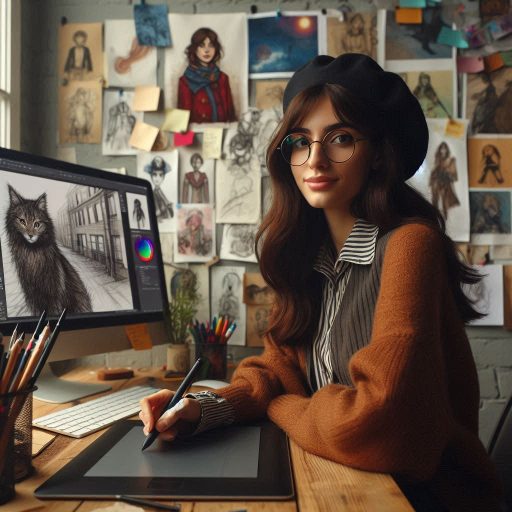Introduction
Concept artists are vital to bringing imaginative worlds, characters, and ideas to life across various industries, including film, video games, advertising, and animation.
These professionals are tasked with transforming abstract ideas into visual concepts that can be developed into final products.
However, the journey to becoming a concept artist can take different forms, with two primary paths emerging: freelance work and in-house positions.
Both freelance and in-house concept artists contribute significantly to creative projects but differ in their approach, work environment, and day-to-day experiences.
Freelancers typically operate independently, working on a project-by-project basis, choosing their clients, setting their own schedules, and determining the types of projects they want to pursue.
In contrast, in-house concept artists are employed by companies, studios, or design firms, where they work within a team, often on long-term projects with more structured goals.
Each path offers unique advantages, along with specific challenges that can impact career growth, creative freedom, and work-life balance.
The purpose of this blog post is to compare the pros and cons of freelance and in-house concept artists, providing a detailed look at the benefits and trade-offs associated with each career path.
We will explore factors such as job flexibility, creative autonomy, financial stability, career progression, and the influence of work environments.
By understanding these differences, aspiring concept artists can better evaluate which path aligns with their professional goals, lifestyle preferences, and long-term ambitions.
Pros of Freelance Concept Artists
Ability to Work on a Variety of Projects
Freelance concept artists enjoy the significant advantage of working on a variety of projects.
This diversity keeps their creative juices flowing and helps them avoid monotony.
Freelancers can explore different styles, themes, and industries, allowing them to develop a versatile portfolio.
This broad experience can attract more clients and lead to exciting opportunities.
Working on various projects also enables artists to refine their skills and discover new techniques, enhancing their overall artistry.
Flexibility in Work Schedule
Another key benefit of freelancing is the flexibility in work schedules.
Freelance artists can choose when and where to work, enabling them to balance personal and professional commitments.
This flexibility allows artists to work during their most productive hours, whether early morning or late at night.
They can also take breaks as needed, contributing to a healthier work-life balance.
This autonomy often leads to greater job satisfaction and less burnout compared to traditional roles.
It empowers artists to create in environments that inspire them.
Opportunity to Work with Different Clients and Companies
Freelancers also have the opportunity to work with various clients and companies.
This exposure helps them build a diverse network within the industry.
Working with different clients allows freelancers to learn from various perspectives and practices.
They can adapt their skills to meet unique client needs, increasing their marketability.
This variety also helps them develop strong interpersonal skills, which are vital in any creative role.
Engaging with multiple companies can lead to long-lasting partnerships and a steady stream of referrals.
Possibility of Higher Pay Rates
Moreover, freelancers often have the possibility of higher pay rates.
Many clients are willing to pay premium rates for specialized skills and unique styles.
Freelancers can negotiate their rates based on their experience, project complexity, and urgency.
Unlike in-house artists, they can increase their earnings by taking on multiple projects simultaneously.
This potential for higher income can be particularly appealing to those who are skilled and have a strong reputation in the industry.
It allows artists to set financial goals that align with their lifestyle aspirations.
Freelance concept artists enjoy unique advantages that can lead to a fulfilling and successful career.
The ability to work on a variety of projects keeps the work fresh and exciting.
Flexibility in scheduling allows for a better work-life balance.
Collaborating with different clients enhances skills and builds valuable relationships.
Finally, the potential for higher pay rates makes freelancing a lucrative option.
Those who thrive on creativity, flexibility, and independence may find freelancing to be the ideal path for their artistic journey.
Read: Breaking Down Iconic Movie Costumes
Cons of Freelance Concept Artists
Inconsistent Income
One significant drawback of being a freelance concept artist is the inconsistent income.
Unlike in-house artists who receive a steady paycheck, freelancers often face fluctuating earnings.
This variability can make budgeting and financial planning challenging.
Many factors, such as project availability and client payments, contribute to income instability.
This uncertainty can lead to financial stress, especially during slow periods.
Freelancers must be proactive in securing projects to maintain a steady cash flow.
Lack of Job Security
Freelancers also experience a lack of job security.
They do not have the same protections and benefits as in-house employees, such as health insurance or retirement plans.
Freelancers often work without a guaranteed salary, making their financial situation precarious.
This lack of security can be especially daunting for those with family or financial obligations.
Additionally, economic downturns can impact freelance opportunities more than traditional employment.
Freelancers must constantly hustle to secure new clients and projects.
Responsibility for Finding and Managing Clients
Another con is the responsibility for finding and managing clients.
Freelance artists must actively market themselves, which requires time and effort.
They need to create a portfolio, network, and maintain an online presence to attract clients.
This self-promotion can be overwhelming, especially for artists who prefer to focus solely on their craft.
Once clients are secured, freelancers must handle contracts, negotiations, and project management.
This multifaceted role can detract from the time spent on creative work.
Isolation from Working in a Team Environment
Freelancers often experience isolation from working in a team environment.
Unlike in-house artists, who collaborate with colleagues and receive immediate feedback, freelancers work independently.
This isolation can lead to feelings of loneliness and disconnection from the creative community.
The lack of collaboration can also hinder skill development and growth.
Freelancers miss out on valuable opportunities to learn from peers and share ideas in a team setting.
This absence of teamwork can impact both creativity and motivation.
While freelancing offers numerous benefits, it also presents several challenges.
Inconsistent income and a lack of job security can create financial strain.
The responsibility for finding and managing clients requires significant effort, often detracting from creative pursuits.
Additionally, the isolation of working independently can hinder personal and professional growth.
Aspiring freelance concept artists should carefully weigh these cons against the pros to determine if this career path aligns with their goals and lifestyle.
Read: Famous Costume Designers in Hollywood
Pros of In-House Concept Artists
Stable Income and Benefits
One of the most significant advantages of being an in-house concept artist is the stable income and benefits.
In-house artists receive a regular paycheck, providing financial security and predictability.
This stability makes budgeting and planning for the future much easier.
Additionally, many companies offer health insurance, retirement plans, and paid time off, which are essential for long-term financial well-being.
These benefits contribute to a sense of security that freelance artists may not experience.
Access to a Team Environment for Collaboration and Feedback
In-house concept artists benefit from working in a collaborative team environment.
This setting allows for immediate feedback and support from colleagues, enhancing the creative process.
Artists can brainstorm ideas together and refine concepts more effectively.
Working with a team fosters a sense of camaraderie and shared goals, leading to improved morale and motivation.
This collaboration can spark new ideas and elevate the quality of the final product, making it a valuable aspect of in-house work.
Opportunities for Career Growth Within the Company
Another significant advantage is the potential for career growth within the company.
In-house artists often have the opportunity to advance their careers through promotions and skill development.
Many companies invest in training and professional development, allowing artists to enhance their skills and knowledge.
This path can lead to positions with more responsibility, such as lead artist or art director.
Career advancement opportunities provide a clear trajectory for artists looking to grow in their field and achieve long-term goals.
Potential for More Consistent Work
In-house artists typically experience more consistent work compared to freelancers.
They usually have a steady stream of projects assigned by their employer, reducing the uncertainty of job availability.
This consistency allows artists to focus on honing their craft without the pressure of constantly seeking new clients.
Additionally, in-house roles often involve long-term projects, providing a sense of stability and continuity.
This predictability can lead to increased job satisfaction, as artists can invest time and effort into meaningful work.
In-house concept artists enjoy several advantages that contribute to a fulfilling career.
Stable income and benefits provide financial security, while access to a collaborative team enhances creativity.
Opportunities for career growth within the company allow artists to advance their skills and responsibilities.
Finally, the potential for more consistent work reduces uncertainty and enables artists to focus on their craft.
For those who value stability, collaboration, and professional development, an in-house role may be the ideal path in the concept art field.
Read: Essential Skills for Aspiring Costume Designers

Cons of In-House Concept Artists
Limited Creative Freedom
One of the main drawbacks of being an in-house concept artist is limited creative freedom.
In-house artists often work on specific projects assigned by their company, which can restrict their artistic expression.
They must adhere to the company’s vision, guidelines, and branding requirements.
This focus on meeting client expectations may stifle creativity and experimentation.
Artists might find themselves working on concepts that do not align with their personal interests or styles.
This lack of creative autonomy can lead to dissatisfaction over time.
Less Flexibility in Work Schedule
In-house concept artists also face less flexibility in their work schedules compared to freelance artists.
They typically adhere to a standard workweek, which can be restrictive for those who prefer a more adaptable routine.
Fixed hours can limit an artist’s ability to work during their most productive times.
This structure can also make it difficult to balance personal commitments and work responsibilities.
While some companies may offer remote work options, the overall flexibility is generally less than what freelancers enjoy.
Subject to Office Politics and Hierarchy
In-house artists may find themselves subject to office politics and hierarchical structures.
Navigating relationships with colleagues and superiors can sometimes be challenging.
Decisions made by management can directly impact an artist’s work, leading to frustration if their ideas are overlooked.
This dynamic can create a competitive environment that detracts from collaboration and creativity.
Artists may need to align with the company’s priorities rather than focusing solely on their artistic vision.
Potentially Lower Pay Rates
Another significant con is the potentially lower pay rates compared to freelance artists.
While in-house roles offer stability, they often come with fixed salaries that may not match the earning potential of freelancing.
Freelancers can negotiate their rates based on project complexity and urgency, sometimes leading to higher income.
In-house positions, on the other hand, may offer limited room for salary increases.
This discrepancy can be a deterrent for those motivated by financial incentives, especially if they have significant student debt or financial responsibilities.
While in-house concept artists enjoy several benefits, they also face notable challenges.
Limited creative freedom and less flexibility in work schedules can be frustrating for some artists.
Navigating office politics and hierarchical structures may hinder their ability to express themselves fully.
Additionally, potentially lower pay rates compared to freelancing can be a significant consideration.
Artists should weigh these cons against the pros when deciding whether an in-house position aligns with their career goals and creative aspirations.
Transform Your Career Today
Unlock a personalized career strategy that drives real results. Get tailored advice and a roadmap designed just for you.
Start NowRead: Networking Events for Costume Designers
Comparison of Freelance vs.In-House Concept Artists
Factors to Consider When Deciding Between Freelance and In-House Positions
When choosing between freelance and in-house positions as a concept artist, several factors come into play.
Financial stability is a significant consideration; freelancers often face income variability, while in-house artists enjoy a consistent salary.
Creative freedom is another important factor; freelancers can choose their projects, while in-house artists may have to adhere to company guidelines.
Additionally, work-life balance varies significantly between the two.
Freelancers have flexible schedules but must manage their own workload.
In-house artists typically work fixed hours but benefit from a team environment and support.
Personal Preferences and Career Goals That May Influence the Decision
Personal preferences and career goals play a crucial role in this decision.
Artists who thrive on independence and variety may prefer freelancing, as it allows them to explore diverse projects and clients.
On the other hand, those seeking stability, mentorship, and opportunities for growth may find in-house positions more appealing.
Career aspirations also matter; if an artist aims for leadership roles, in-house opportunities might offer a clearer path for advancement.
Understanding individual goals and work styles can guide artists in making the best choice for their careers.
Importance of Weighing the Pros and Cons of Each Option Before Making a Choice
It is essential to weigh the pros and cons of each option before making a decision.
Freelancing offers flexibility and the chance to work on varied projects, but it comes with income uncertainty and self-management challenges.
In-house positions provide stability and collaboration but may limit creative freedom and have fixed schedules.
Taking the time to evaluate these factors can help artists make informed decisions that align with their career objectives and lifestyle preferences.
The Diversity of Opportunities Available in the Concept Art Industry
The concept art industry offers a diverse range of opportunities for both freelance and in-house artists.
From video games and films to advertising and graphic novels, artists can find their niche in many fields.
Freelancers can diversify their portfolios by working with various clients across multiple industries.
In-house artists can benefit from being part of a larger creative team, contributing to comprehensive projects.
Both paths offer unique advantages, allowing artists to find fulfilling work that suits their skills and passions.
Ultimately, the choice between freelance and in-house roles should reflect individual preferences and career aspirations.
The decision between freelance and in-house positions involves careful consideration of various factors.
Personal preferences, career goals, and the pros and cons of each option should guide artists in their choices.
The concept art industry is rich with diverse opportunities, ensuring that artists can find a path that aligns with their creative aspirations.
By taking the time to evaluate their options, artists can make informed decisions that will support their careers and artistic journeys.
Conclusion
Both freelance and in-house concept artist careers come with their own distinct advantages and challenges.
Freelance concept artists have the freedom to choose their projects, set their own schedules, and potentially earn more based on the volume and type of work they secure.
This path offers a high degree of creative flexibility, allowing artists to explore different industries, styles, and clients.
However, the freelance lifestyle also brings uncertainties, such as inconsistent income, the constant need to find new clients.
The requirement to handle administrative tasks like contracts, taxes, and marketing.
In contrast, in-house concept artists benefit from a more stable and structured work environment.
They enjoy a steady paycheck, access to company resources, and opportunities for collaboration with other creative professionals in a consistent team setting.
This role often allows for deeper involvement in long-term projects, providing the chance to refine and develop ideas within a specific brand or franchise.
However, in-house artists may face creative limitations due to company guidelines or project restrictions, and their schedules are often dictated by the employer, leading to less flexibility.
[E-Books for Sale]
The Big Book of 500 High-Paying Jobs in America: Unlock Your Earning Potential
$19.99 • 500 High-Paying Jobs • 330 pages
Explore 500 high-paying jobs in America and learn how to boost your career, earn more, and achieve success!
See All 500 High-Paying Jobs of this E-Book
1001 Professions Without a Degree: High-Paying American Jobs You Can Start Now
$19.99 • 1001 Professions Without a Degree • 174 pages
Discover 1001 high-paying jobs without a degree! Unlock career tips, skills, and success strategies for just $19.99!




